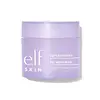What's inside
What's inside
 Key Ingredients
Key Ingredients

 Benefits
Benefits

 Concerns
Concerns

 Ingredients Side-by-side
Ingredients Side-by-side

Water
Skin ConditioningButylene Glycol
HumectantGlycerin
HumectantDimethicone
EmollientPEG-240/Hdi Copolymer Bis-Decyltetradeceth-20 Ether
StabilisingNiacinamide
SmoothingTrehalose
HumectantSqualane
EmollientCentella Asiatica Extract
CleansingTremella Fuciformis Sporocarp Extract
AntioxidantTocopheryl Acetate
AntioxidantTocopherol
AntioxidantPropanediol
Solvent1,2-Hexanediol
Skin ConditioningGellan Gum
Acrylates/C10-30 Alkyl Acrylate Crosspolymer
Emulsion StabilisingCaprylhydroxamic Acid
Tromethamine
BufferingSodium Chloride
MaskingSodium Citrate
BufferingPotassium Laurate
EmulsifyingSodium Benzoate
MaskingPotassium Sorbate
PreservativePhenoxyethanol
PreservativeEthylhexylglycerin
Skin ConditioningWater, Butylene Glycol, Glycerin, Dimethicone, PEG-240/Hdi Copolymer Bis-Decyltetradeceth-20 Ether, Niacinamide, Trehalose, Squalane, Centella Asiatica Extract, Tremella Fuciformis Sporocarp Extract, Tocopheryl Acetate, Tocopherol, Propanediol, 1,2-Hexanediol, Gellan Gum, Acrylates/C10-30 Alkyl Acrylate Crosspolymer, Caprylhydroxamic Acid, Tromethamine, Sodium Chloride, Sodium Citrate, Potassium Laurate, Sodium Benzoate, Potassium Sorbate, Phenoxyethanol, Ethylhexylglycerin
Water
Skin ConditioningGlycerin
HumectantCyclopentasiloxane
EmollientCyclohexasiloxane
EmollientCaprylic/Capric Triglyceride
MaskingDimethicone/Vinyl Dimethicone Crosspolymer
Skin ConditioningButylene Glycol
HumectantPanthenol
Skin ConditioningPyrus Malus Fruit Extract
Skin ConditioningCitrullus Lanatus Fruit Extract
Skin ConditioningSodium Acetylated Hyaluronate
HumectantHydrolyzed Hyaluronic Acid
HumectantSodium Hyaluronate Crosspolymer
HumectantBenzyl Glycol
SolventSodium Hyaluronate
HumectantChamomilla Recutita Flower Extract
MaskingHippophae Rhamnoides Fruit Extract
Skin ConditioningOenothera Laciniata Extract
HumectantLavandula Angustifolia Flower Extract
CleansingSalvia Officinalis Extract
AntimicrobialRosa Canina Fruit Extract
AstringentRubus Fruticosus Fruit Extract
AstringentRosa Hybrid Flower Extract
Skin ConditioningCorallina Officinalis Extract
Skin ConditioningLaminaria Japonica Extract
Skin ProtectingHizikia Fusiforme Extract
Skin ConditioningGlutathione
Dipropylene Glycol
HumectantCetyl PEG/PPG-10/1 Dimethicone
EmulsifyingSodium Chloride
MaskingDimethicone
Emollient1,2-Hexanediol
Skin ConditioningCaprylyl Glycol
EmollientIllicium Verum Fruit Extract
PerfumingPolysilicone-11
Parfum
MaskingDisodium EDTA
Ethylhexylglycerin
Skin ConditioningWater, Glycerin, Cyclopentasiloxane, Cyclohexasiloxane, Caprylic/Capric Triglyceride, Dimethicone/Vinyl Dimethicone Crosspolymer, Butylene Glycol, Panthenol, Pyrus Malus Fruit Extract, Citrullus Lanatus Fruit Extract, Sodium Acetylated Hyaluronate, Hydrolyzed Hyaluronic Acid, Sodium Hyaluronate Crosspolymer, Benzyl Glycol, Sodium Hyaluronate, Chamomilla Recutita Flower Extract, Hippophae Rhamnoides Fruit Extract, Oenothera Laciniata Extract, Lavandula Angustifolia Flower Extract, Salvia Officinalis Extract, Rosa Canina Fruit Extract, Rubus Fruticosus Fruit Extract, Rosa Hybrid Flower Extract, Corallina Officinalis Extract, Laminaria Japonica Extract, Hizikia Fusiforme Extract, Glutathione, Dipropylene Glycol, Cetyl PEG/PPG-10/1 Dimethicone, Sodium Chloride, Dimethicone, 1,2-Hexanediol, Caprylyl Glycol, Illicium Verum Fruit Extract, Polysilicone-11, Parfum, Disodium EDTA, Ethylhexylglycerin
 Reviews
Reviews

Ingredients Explained
These ingredients are found in both products.
Ingredients higher up in an ingredient list are typically present in a larger amount.
1,2-Hexanediol is a synthetic liquid and another multi-functional powerhouse.
It is a:
- Humectant, drawing moisture into the skin
- Emollient, helping to soften skin
- Solvent, dispersing and stabilizing formulas
- Preservative booster, enhancing the antimicrobial activity of other preservatives
Butylene Glycol (or BG) is used within cosmetic products for a few different reasons:
Overall, Butylene Glycol is a safe and well-rounded ingredient that works well with other ingredients.
Though this ingredient works well with most skin types, some people with sensitive skin may experience a reaction such as allergic rashes, closed comedones, or itchiness.
Learn more about Butylene GlycolDimethicone is a type of synthetic silicone created from natural materials such as quartz.
What it does:
Dimethicone comes in different viscosities:
Depending on the viscosity, dimethicone has different properties.
Ingredients lists don't always show which type is used, so we recommend reaching out to the brand if you have questions about the viscosity.
This ingredient is unlikely to cause irritation because it does not get absorbed into skin. However, people with silicone allergies should be careful about using this ingredient.
Note: Dimethicone may contribute to pilling. This is because it is not oil or water soluble, so pilling may occur when layered with products. When mixed with heavy oils in a formula, the outcome is also quite greasy.
Learn more about DimethiconeEthylhexylglycerin (we can't pronounce this either) is commonly used as a preservative and skin softener. It is derived from glyceryl.
You might see Ethylhexylglycerin often paired with other preservatives such as phenoxyethanol. Ethylhexylglycerin has been found to increase the effectiveness of these other preservatives.
Glycerin is already naturally found in your skin. It helps moisturize and protect your skin.
A study from 2016 found glycerin to be more effective as a humectant than AHAs and hyaluronic acid.
As a humectant, it helps the skin stay hydrated by pulling moisture to your skin. The low molecular weight of glycerin allows it to pull moisture into the deeper layers of your skin.
Hydrated skin improves your skin barrier; Your skin barrier helps protect against irritants and bacteria.
Glycerin has also been found to have antimicrobial and antiviral properties. Due to these properties, glycerin is often used in wound and burn treatments.
In cosmetics, glycerin is usually derived from plants such as soybean or palm. However, it can also be sourced from animals, such as tallow or animal fat.
This ingredient is organic, colorless, odorless, and non-toxic.
Glycerin is the name for this ingredient in American English. British English uses Glycerol/Glycerine.
Learn more about GlycerinChances are, you eat sodium chloride every day. Sodium Chloride is also known as table salt.
This ingredient has many purposes in skincare: thickener, emulsifier, and exfoliator.
You'll most likely find this ingredient in cleansers where it is used to create a gel-like texture. As an emulsifier, it also prevents ingredients from separating.
There is much debate on whether this ingredient is comedogenic. The short answer - comedogenic ratings don't tell the whole story. Learn more about comegodenic ratings here.
The concensus about this ingredient causing acne seems to be divided. Research is needed to understand if this ingredient does cause acne.
Scrubs may use salt as the primary exfoliating ingredient.
Learn more about Sodium ChlorideWater. It's the most common cosmetic ingredient of all. You'll usually see it at the top of ingredient lists, meaning that it makes up the largest part of the product.
So why is it so popular? Water most often acts as a solvent - this means that it helps dissolve other ingredients into the formulation.
You'll also recognize water as that liquid we all need to stay alive. If you see this, drink a glass of water. Stay hydrated!
Learn more about Water